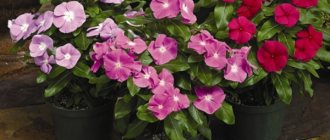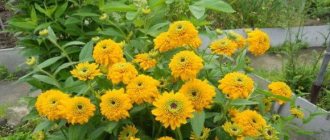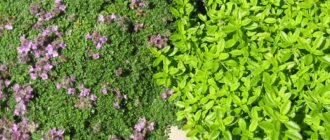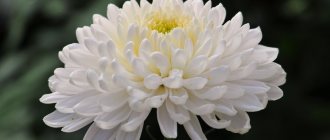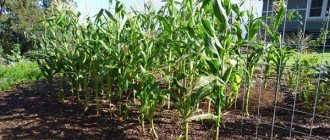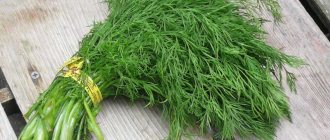Creeping thyme: varieties and varieties
Creeping thyme is a type of low-growing shrub. The height of the plant rarely reaches more than 15 cm. It is called so because of its ability to spread along the soil, forming a soft, fragrant carpet. The flowers have a bright purple hue and are collected in capitate inflorescences. This type is most often used by gardeners. It is used in landscape design because it blooms continuously all summer. The most common varieties of thyme are:
- "Colchis" - has light lilac flowers and spreads low (10 cm) along the ground;
Variety "Colchis"
- “Donna Valley” - grows in a dense carpet, the leaves are bordered by a yellow stripe, the flowering is constant pink;
- “Silver Queen” - forms a rather high (20 cm) loose carpet, the leaves are gray with a white edge, the inflorescences are densely arranged and have a pale lilac tint.
Creeping thyme is a type of thyme, among which you can also find:
- Common thyme. A plant with a small height of 5-10 cm. The leaves below have a light fluff. Blooms are white and soft lilac.
Common thyme
- Lemon-scented thyme. It got its name due to its spicy aroma with subtle lemon notes, as well as the yellowish color of young leaves. The most popular varieties:
Lemon-smelling thyme
- "Aurea" - has a bright yellow color;
- "Bertram Anderson" - has green leaves covered with yellow spots.
- Early thyme. It blooms earlier than others, but also fades a little faster. The following varieties are found in our country:
early thyme
- "Minor" - characterized by the slowest growth and small fluffy leaves;
- "Pseudolanuginosus" - has sharp green leaves with excessive pubescence, blooms very profusely.
Botanical description and range of thyme
A perennial with woody stems on which herbaceous branches are located. The height of the plant can reach 35 cm. The size and shape of the hard leaves varies depending on the type: from round to linear-oblong. The edges of the leaf blades are usually entire, less often jagged. In the summer months, flowers appear collected in inflorescences in white, pink or purple shades. After the flowering period ends, fruits appear - seed pods.
The subshrub is widely distributed in Russia and Central Asia. Usually settles on sandy soils. Prefers open places, forest glades, coniferous and deciduous forests. Due to its unpretentiousness, thyme is found even in North Africa.
Planting a plant
Thyme is grown in light, loose soil. Sunlight has a beneficial effect on its development, so planting in open ground is carried out in a well-lit place.
In order for perennial plants to take root well, the site must be carefully dug up in the fall. And add organic fertilizer (compost or manure). In the spring, when the weather is warm outside with a temperature of at least 13°C, the soil is dug up again and the seeds are sown.
Advice! After the thyme has been sowed, you can sprinkle the seeds with river sand. It will provide young shoots with additional nutrients and prevent water from stagnating on the surface.
After the seedlings sprout and grow a little, it is necessary to thin out the planting. The ideal distance between plants is 30-35 cm.
Fertilize and dig up the soil before planting thyme
In open ground, planting can also be done using seedlings. To do this, at the end of winter, thyme is sown in prepared trays. Watering the seedlings is carried out regularly, but not abundantly. Thyme grows under glass, which creates a greenhouse effect. After 3-4 weeks, the seedlings are taken out into the open air for hardening, and after another 2 weeks they are planted in a permanent place.
Reproduction
Thyme is propagated by seeds, cuttings and dividing the bush. It should be noted that the plant can reproduce well and abundantly by self-sowing, so over time it will be necessary to limit the area of its growth.
Since thyme seeds are very small and will take almost a month to germinate, the area should be thoroughly cleared of weeds before sowing in the ground. After germination, young plants develop rather slowly and will require protection from weeds. That is why, when propagating from seeds, it is first better to grow seedlings in containers. At the beginning of March, seeds are sown in the soil mixture (equal parts of peat and sand), and the box is covered with glass on top until seedlings emerge. The grown seedlings are planted in the ground.
In summer, thyme propagates well from green cuttings. The shoots take root well, so before flowering, the tops of the stems, 8-10 cm long, are cut off, planted in river sand, and covered with film. During the day, the cuttings must be sprayed several times with a spray bottle. The roots appear on the 15-20th day, and after a month the finished seedlings can be planted on the site. Growing thyme in its first year involves regular weeding and loosening the soil (mulching) to prevent water from stagnating
When propagating by division, the bush is broken at the base, after which the small roots are carefully disassembled (untangled). The planted cuttings can be covered with a glass jar for a week for better rooting.
Thyme care
The first thing you need to do for thyme after planting is to pinch the tip of the stem, so the plant will form into a beautiful lush bush. Perennial crops require seasonal pruning. In the fall, when the thyme has stopped flowering, it is necessary to shorten the bushes. In the new season you will see how this procedure helped the plant become denser and acquire a decorative shape.
As it grows, shape the plant to get a beautiful bush
Regular weeding and removal of weeds, which draw most nutrients from the soil, are very important for thyme. Since thyme already grows rather slowly, “undesirable neighbors” will further inhibit its growth.
Caring for the plant also involves watering it, which should be done no more than twice a week in dry weather and even less often if the summer is not very hot.
Important! Cover perennial plants with peat or fallen leaves for the winter.
Description of the plant
Thyme is a representative of the Lamiaceae genus and belongs to the Lamiaceae family. This is a perennial plant that can be cultivated as an annual within the garden. In nature, different types of grass grow everywhere, and large populations are concentrated in the mountains, steppes and floodplains. This low bush likes sunny, windless areas and clear weather. Black thyme is not picky about the mechanical composition of the soil, since, thanks to its developed root system, it can obtain water from great depths.
Thyme is unpretentious and resilient. The grass does not need fertilizing or frequent watering. All she needs is space for her long creeping shoots to grow. Flowering begins early, already in mid-June and lasts until the cold weather.
Note! In nature, thyme does not grow as quickly as in a cultivated summer cottage. This is because in the garden the soil is more enriched with minerals, which contribute to the rapid growth of creeping shoots. This must be taken into account and timely pruning must be done.
Thyme stems and leaves have medicinal properties. They are rich in vitamins, salts, amino acids and essential oils. Therefore, after flowering, the summer resident does not rush to pull out the grass and throw it away - first he cuts off the useful above-ground parts and dries them. In this form, decoctions are prepared from them, black tea is brewed, and used as a seasoning for meat and poultry.
Fertilizer and feeding
It is undesirable for thyme to add fresh manure to the soil. Growing thyme in open ground allows the use of wood ash. It will not only add nutrients to the soil, but also reduce acidity.
Feed the perennial with mineral fertilizers
The first fertilization of thyme is carried out with urea in early spring. If this is the first year, then before germination, and in the second and subsequent years during spring pruning.
Advice! Mineral fertilizers can be applied from the second year of life of creeping thyme.
How to grow thyme from seeds (video)
Dried and fresh raw materials are boiled and consumed for:
- blood pathologies;
- neuralgic ailments;
- hypotension;
- joint inflammation;
- cardiac disorders;
- insomnia;
- loss of appetite.
Despite the fact that the creeping plant brings many benefits, it has contraindications for gastritis and duodenal ulcers. It is not recommended for pregnant women to take medications based on it.
Thyme propagation
Reproduction of creeping thyme varieties in open ground is carried out in three ways:
- Seeds. Planting material is collected in the fall and dried until spring. Then they are sown and covered with film. It is also possible to plant seeds in the fall.
Pattern: thyme bush
- By cuttings. This method is convenient because the seedlings are already strong. Cuttings are selected during spring or autumn pruning. The strongest of all are taken for planting. It is they who will subsequently form a new bush.
- Dividing the bush. A very painful method for the plant. When carrying out such propagation of thyme, the entire bush is dug up and divided in half. Special care is required. It is very important not to damage the root system, otherwise the plant may get sick or even die.
Thyme: planting and care at home
Thyme tolerates cultivation at home quite well, so in the fall and winter you can always have a sprig of fresh aromatic seasoning on hand. For planting, you can use cactus soil. Thyme seeds can be sown in the spring, but it is better to take a bush from the garden in the fall, divide it and plant it in a container. In this case, the pot is chosen quite a bit wider than the roots of the plant. It is very important to ensure good drainage, because thyme does not tolerate waterlogging.
In order for thyme to grow and develop normally, it needs to be provided with the maximum possible amount of light, so it is installed on the southern, brightest window. Otherwise, the thyme will stretch upward without forming a dense bush with lush greenery.
Diseases and pests
Creeping thyme is very resistant to attacks by pathogenic bacteria and pests. Planting and caring for it is not difficult. It is unpretentious, but the only drawback is its slow growth.
The main pests of Bogorodskaya grass are:
- weevil;
- meadow moth;
- aphid;
- sandy sluggish.
The sand beetle
Thyme can also be affected by some fungal diseases. This happens due to violations of agricultural cultivation techniques. Excessive watering, infrequent weeding, and shading of the plant lead to the spread of fungi on it.
Deep plowing, regular loosening of the root area of the soil, and timely weeding will save you from insect pests. Pests can also be removed by applying fertilizer containing lime or other alkaline fertilizers.
Thyme in the home medicine cabinet
Before the advent of antibiotics, the oil obtained from common thyme was a powerful antiviral, antifungal and antibacterial agent. Thyme contains caffeic, quinic, oleic, chlorogenic, ursulic and oleanolic acids, fats, gum, flavonoids, vitamin C and many mineral salts. Thyme tea and various infusions help with various diseases (cough, bronchitis, whooping cough, reduces blood pressure and stimulates blood circulation), and are used as an immune stimulant and a general tonic. In addition, thyme is considered an aphrodisiac.
In cooking, thyme is used as a spice and seasoning, but more often it is part of various spicy mixtures.
If dried thyme is sewn into a bag and placed in a closet, it will reliably protect things from moths.
Creeping thyme: combination with other plants
Thyme looks great in group or joint plantings. It can be used as a background for plants with large textured leaves. Often they play on the contrast of colors in combination with heuchera.
Thyme in landscape design
Creeping thyme attracts a large number of butterflies, bees and other pollinating insects with its powerful aroma. Therefore, it can be planted next to cucumber beds. By flocking to the smell of thyme, bees will help pollinate other vegetable crops.
Thyme or Bogorodskaya herb is the main component in the composition of bouquets made for the holiday of the Holy Trinity. These bundles also contain wormwood, mint and lovage. Since ancient times, it was believed that the combination of their aromas would drive away all evil spirits from the home.
Medicinal and beneficial properties of thyme
Warriors of Ancient Rome and Greece rinsed with water infused with this spicy plant to give them strength. And in Egypt, thanks to its fragrant aromatic oils, the subshrub was used in perfumery and embalming the bodies of the dead.
The plant contains the following substances:
- tannins and resins;
- carvacrol;
- essential oils;
- vitamins;
- minerals;
- bitterness;
- organic acids.
Thanks to its unique components, the miracle herb has a healing effect on people of any age. Products containing thyme provide:
- antiseptic;
- expectorant;
- anti-inflammatory;
- antispasmodic effect.
Lemon thyme is used in the manufacture of products that need to be used to rinse the mouth in case of inflammatory processes, to make baths and lotions to get rid of skin ailments. Experts often prescribe a decoction for respiratory pathologies.
Creeping thyme in landscape design
Being a low shrub that creeps along the ground, thyme is used in landscape design as a background for alpine slides and mixboards. But he can act there in the leading role. Looks very good on rocky screes.
Decorating a rock garden with thyme
Growing creeping thyme will bring you a lot of pleasure. You can enjoy not only the beautiful appearance of the fluffy bushes, but also its wonderful spicy smell. And what bright and rich photos you get against the backdrop of thyme is simply a sight for sore eyes.
Planting thyme in open ground
It doesn't take much effort to grow a plant in your garden and get a fluffy carpet. The culture serves as a real decoration for borders, flower beds and rocky hills. Decorative thyme leaves are very beautiful and can complement the overall picture with an incredible aroma. It fills the garden with a delicate scent, adding mystery to the atmosphere.
For the full development of culture it is necessary to create special conditions. If everything is done correctly, thyme will delight the eye with abundant flowering and saturate it with useful substances. Flower beds designated for growing thyme should be in direct sunlight. If there is not enough light, the bushes of the plant will lose their visual appeal. In the shade, the stems stretch out and become thin, the flowers of the crop become smaller and bloom earlier than usual.
Varieties of thyme: photo
Biological characteristics of the plant
Creeping thyme (“Bogorodskaya grass”) belongs to the group of perennial herbaceous plants of the Lamiaceae family.
This is a miniature bush 15-20 centimeters high, with creeping (creeping) stems, which, as they grow, create a picturesque carpet. The stems at the bottom become woody. The shape of the plant is often petiolate - lateral stepsons grow from one shoot, on which flowering will later begin. The leaves are ovate, bright green, medium in size, up to one centimeter long. Along the edges, the leaves have deep, even teeth, cutting the plate almost in half.
Thyme blooms with small, pale lilac flowers, which are collected in large capitate inflorescences.
Volumetric loose inflorescences are located at the very top of the stems. After flowering, the fruit remains, which consists of four medium-sized nuts. Thyme has a strong aromatic odor. Blooms in June-July. By the way! It is creeping thyme that landscape designers use for landscaping garden areas.
Description of thyme
Thyme is a perennial of the Thyme genus of the Yamaceae family. It grows as a subshrub with recumbent shoots. Creeping thyme reaches a height of 15 cm. The plant forms a thick cover of small leaves and flowers. In some places, adventitious roots form on the stems. Tufts form on slightly raised branches.
On a note! In the wild, thyme is found in sunny meadows, near stones or along roadsides.
Thyme leaves are dark green, elliptical or lanceolate, 5-10 mm long. They are placed opposite on the stems. The short petioles of the leaves contain a large amount of essential oil. The plant has a spicy odor. The width of the leaf blade is 1-3 mm. Its edges are smooth, unlike other representatives of the Thyme genus, in which they are curled. The inflorescences consist of compact heads with narrow bell-shaped calyxes, the average length of which is 4 mm. The flowers of Bogorodskaya grass are two-lipped and small. The corolla is lilac-pink, 6-8 mm long. The shrub blooms in June-July. In the second ten days of August, fruits begin to form on it - ellipsoidal nuts up to 0.5 mm in length.
Thyme: growing from seeds, planting, care
In summer cottages you can often find lush purple or lilac blooms. This is thyme: growing from seeds is possible along with other methods of propagation.
Thyme
Appearance of thyme
Thyme is a flowering perennial subshrub with a creeping, creeping or ascending stem. Another name for the plant is thyme. The average height of thyme is 35 cm, the leaf size is 0.3 - 0.8 cm. The inflorescences in the form of a spike of lilac, pink, purple or white fragrant flowers have a strong aroma that attracts insects.
Appearance of thyme
Thyme blooms in early May and ends flowering at the end of summer.
Variety of thyme varieties
The species has 300 varieties growing in Europe, Asia and Africa. Only those for which it is possible to create favorable conditions independently are grown on personal plots.
Table. Varieties of thyme for planting in the country house or in the courtyard of a private house.
NameLength of stems and nature of vegetationFlowersLeavesApplication
| Common thyme | Bush height 15 cm, subshrub with ascending shoots | White or light purple | Small, with fluff on the bottom | For medical purposes |
| Lemon thyme | Stems 30 cm spreading or erect, the bush is usually pruned to give a rounded appearance | Lilac color | Oval in shape, greenish-yellow in young plants, light green in adults | In cooking as a lemon-flavored seasoning for dishes and drinks |
| Dwarf thyme | Dense and dense vegetation 5 cm high | White, scarlet or red | Small, 3 – 5 mm | Landscape design |
| creeping thyme | Stems are curly, long | Pink and crimson, blooms in late summer | Large, about 1 cm | For medical purposes |
| Rainbow thyme | 20 – 25 cm | Purple or pink | Grayish green color | Landscape design, window sill decoration, seasoning for food and drinks |
Lemon thyme (lemon-scented or vegetable)
Growing thyme from seeds
Of all the propagation methods for thyme, the most successful is planting with seeds. Thyme has a lot of seeds, and in the end you get more plants than when dividing or cuttings. It is important to correctly determine the place for sowing, prepare the site and care for the seedlings.
Thyme varieties with pink and purple flowers
Step-by-step instruction
- Choosing a landing site.
Thyme grows in an open and well-lit area. It is not planted on paths between trees or in other shaded places. A front garden or alpine hill is suitable for growing. Thyme grown in an open area - Soil preparation.
The soil for planting must be porous. Seeds are sown in early spring or late autumn. If you plan planting in early spring, then in the fall the area is dug up to loosen the soil. Then the roots of the weeds are removed. Compost or mineral phosphorus-potassium fertilizers are added to the soil. Before planting, the soil should not be fertilized with manure; it is not needed for thyme. In the spring, the soil is loosened again and urea is added. Seeds are sown one day after fertilizing the soil. The soil for thyme should be soft - Sowing seeds in the ground. For sowing, you need to choose days when the weather has already established without frost. We need a warm and not rainy time.
Thyme seedsWhen sowing in rows, make a distance of at least 30 cm between them. Thyme grows and needs space. Experienced gardeners recommend sprinkling the crops with river sand. The minerals contained in it will enrich the soil with nutrients. Germination requires a greenhouse effect, so the bed is covered with film.
The crops are covered with film to create a greenhouse effect.
- Expect sprouts to appear within two weeks.
Thyme seeds have good germination, so you may end up with too many plants. Then the weak plants are removed from the rows to give the strong ones the opportunity to fully develop. Thyme shoots in open ground
Growing seedlings
Thyme can be grown as seedlings and then the plants are planted in the ground. In this case, sowing occurs in mid-March. Plant the seeds in a tray containing prepared soil. The tray is covered with film. The plants will be ready for planting in open ground in two months. They must be strong and healthy. Seedlings are planted keeping the same distances as when sowing seeds.
Strengthened seedlings for future seedlings
Growing and care
Proper care is necessary for the plant for its normal development and timely flowering. Sick plants die, so you should follow some rules for growing thyme:
- Regularly remove weeds in and between rows. At the same time, lightly loosen the soil around the bushes.
- Do not allow the soil to dry out or water to stagnate. When the soil becomes acidic, gray rot appears on the stems and the plant dies. Excessive watering should be avoided; thyme needs the most moisture during the period of preparation for flowering. To prevent water from stagnating, the ground is mulched with gravel. The plant easily tolerates short-term drought.
- Thyme grows in one area for five years, then it is replanted.
- In the fall, before frost sets in, the plants are pruned and shaped.
Trim off those parts of the stems that have not yet become woody. In winter, thyme is covered with peat or fallen leaves to prevent it from freezing. Autumn pruning of thyme
Important! Fertilizing is applied annually in the spring. In the first year, nutrients added before planting are sufficient. A year or later, potassium humate is added.
- Dried inflorescences are removed after thyme blooms.
Dried inflorescences must be removed
Diseases and pests
With proper watering and timely weeding, the plant will be healthy. Pests are also rare on thyme due to its pronounced aroma. However, there are cases of harmful insects appearing:
- weevil;
- aphid;
- meadow moth;
- sand slow.
Insects damage young shoots, buds and flowers. To combat them, plants are treated with insecticides.
Important! If affected by sand slugger and weevil, you need to additionally spread out the poisoned bait.
Leaf affected by aphids
Growing thyme on a windowsill
Thyme can also be grown as a potted plant. This way you will always have seasoning at hand on the kitchen window.
A pot for the plant should be at least 15 cm in diameter. Soil is used as soil, mixed with perlite if desired. Place drainage at the bottom of the pot. The soil is moistened with a flower sprayer to keep it soft.
A few seeds are enough for planting. They need to be spread evenly over the surface, then sprinkled with a layer of soil (no more than 1 cm). Moisten the top and make sure that the surface does not dry out before the sprouts appear. Until the thyme has sprouted, the pot should be in a well-lit place, but not in direct sunlight.
After the greenery has appeared, the pot is placed on the windowsill on the south side of the house.
Thyme shoots on the windowsill
In spring and summer, the plant feels good in the sun, it just needs timely watering. Thyme can also grow in the shade, only then its aroma will not be very pronounced. In addition to watering, you can spray the greens, so they become more beautiful and the vegetative mass grows better. Fertilizing is applied once a year, the same as when growing in the ground.
Important! To form a beautiful plant with a dense arrangement of branches, shoots are pruned in the spring and after flowering. Cut with scissors to the woody part, leaving about a third of the shoot.
With the onset of autumn, even indoor thyme needs a drop in temperature. Place the pot on the balcony if it is insulated. At temperatures below 5 degrees the plant will die. Reduce the frequency of watering and stop spraying. Lighting must be sufficient. Thyme does not need darkening.
Growing thyme indoors
Harvesting
Thyme twigs, leaves or flowers are used in the preparation of dishes and drinks throughout the growing season. But there is also harvesting for medicinal purposes. This is done during the period of intense flowering. Young shoots with flowers and leaves are cut off and then laid out on cloth to dry. You can also tie the branches into bundles and dry them by hanging them from the ceiling.
Drying thyme sprigs for adding to tea and making a decoction
From ancient times there is a belief that the healing properties of thyme are enhanced on the day when Trinity is celebrated. Therefore, our ancestors prepared medicinal herbs on this day.
Thyme in landscape design
Low bushes usually decorate alpine hills or border garden paths. Summer residents arrange rocky placers on the site, which can also be decorated with thyme. A bright plant can be a beautiful backdrop for a photo. The spicy aroma creates a special cozy atmosphere in the courtyard. You can read about how to make a beautiful vegetable garden with your own hands in our article.
In an unusual way, you can design paths or areas lined with large stones. To do this, thyme is sown around the stones, filling the entire space between them with the plant. The owners make sure that the thyme does not grow too much and creates a beautiful pattern.
Stone-paved yard decor
About the benefits and harms of thyme
Like any other medicinal or spicy plant, thyme can not only be useful, but also cause harm.
Benefit:
- Thyme contains a set of vitamins and microelements, which makes its greens a valuable food additive. Spicy greens have a distinct taste and are suitable for cooking meat, vegetables and fish.
- Decoctions and infusions of the dried plant are used during the treatment of colds and infectious diseases of the nasopharynx and bronchi, as well as for indigestion. The decoction increases the vitality of the body, so it is recommended to drink it as tea in the morning if you are depressed or simply in a bad mood.
- Tea with thyme promotes the production of testosterone in men, and also has a special aroma and taste.
Tea with thyme
Harm and contraindications:
- Thymol, which is part of the plant, affects the functioning of the liver and kidneys. If the functions of these organs are impaired, then the use of thyme is contraindicated in any form.
- Thyme is not used for arrhythmia, atherosclerosis and cardiosclerosis.
- If you have high acidity, you should avoid using thyme.
- During pregnancy, use thyme with caution.
If the expectant mother loves tea with thyme, then it is made very weak. You should consult your doctor about the possibility of using it for medicinal purposes. Uses of thyme
Thyme is a versatile plant that not only decorates the yard, but is also suitable for consumption and healing. Thyme is unpretentious and does not require special care, so every gardener can grow it.
Video - Growing thyme
teplica-exp.ru
Reproduction methods
To propagate thyme, you can use one of the following methods: plant seeds, root cuttings, or divide the bush in half. The plant quickly forms new roots. Seed germination is good, but in a warm room the sprouts appear more actively. Proper planting and regular care of creeping thyme ensure good bushiness and lush flowering.
How to properly care
Growing thyme in the garden is not at all difficult. For its full development, the plant needs to be watered twice a week, but you should not overfill the flower beds with water; the soil should be soft, not wet. You also need to monitor the cleanliness of the planting and promptly remove weeds and periodically fluff up the soil. To create a beautiful appearance, the bushes must be pinched periodically. Such manipulations stimulate the appearance of young shoots, which makes the thyme bush more lush and voluminous. In autumn, the stems of thyme are shortened a little, this is done to improve the decorative qualities of the plant.
In principle, creeping thyme does not need to be fed. But to improve the appearance and density of the cover, the plant needs to be fed with urea in the spring, and in the second season you can use complex mineral fertilizers.
Thyme also reacts well to wood ash. It is periodically added to the soil; the ash helps reduce acidity.
Thyme: types and varieties, propagation and care
If thyme (thyme) lives on the site, then the space acquires a homely coziness, which is created by the spicy warm smell of thyme and the dense “carpet” of its leaves and flowers.
Thyme is welcome in the garden. It combines well with most plants and is often used as a ground cover. Small bright leaves of thyme combined with hyssop and low-growing carnations will decorate any container and small flower bed. While walking through the garden, run your hand over a thyme bush and you will find yourself in a cloud of spicy aroma. And on cold winter evenings, tea from this herb can warm not only the body, but also the soul.
Thyme is a bright representative of the Lamiaceae family. The genus includes over 400 species, growing almost throughout the entire territory of the former USSR. The European part pleases with 50 different species. About 40 grow in Siberia and the Caucasus. These are subshrubs with semi-recumbent, ascending or ascending woody stems
The most common are common thyme (Thymus vulgaris) and creeping thyme (Thymus serpyllum).
Refers to medicinal plants. The leaves are small and have pubescence on the inside. Shoots up to 15 cm tall. This species includes several beautiful varieties with different flower colors: “Alba” - white, “Splendens” - deep red. Among the dwarf varieties, we’ll highlight “Elfin” - only about 5 cm tall, but it forms a dense, neat pillow with a diameter of no more than 15 cm. Creeping thyme is known to most under the name thyme, and in Rus' it was affectionately called “Bogorodskaya grass.” This perennial plant with creeping intertwined stems and cylindrical leaves forms a dense carpet on the ground. If you like variegated forms and rich colors - carmine, white, pink, then this look is exactly what you need. Peduncles reach 15 cm in height; the plant has been used for centuries. Creeping thyme (Thymus serpyllum L.). Photo: Borealis55, ru.wikipedia.org. Separately, it is worth noting the varieties of thyme with a pronounced lemon smell. It is a hybrid of two species: pulegioides and vulgaris. In winter it requires shelter, as it is quite thermophilic and does not like sudden drops in temperature. Its shoots reach 30 cm. Its variegated, rounded leaves are very beautiful. The plant is perennial and needs pruning to maintain shape and density. A dense small bush with leaves just over 1 cm adorned with dense heads of pink-purple flowers. The species blooms in June. Flea thyme (Thymus pulegioides). Photo: Andreas Trepte, en.wikipedia.org. Rarely found in culture, lives in the Balkans. It is beautiful, but does not tolerate frost very well. The flowers are gray-pink in color, and the leaves are covered with white hairs and are curved, giving the impression that they have frozen in the wind. This type of thyme is common in the forest zone of Eastern Europe. Subarctic thyme. Photo: Evgeny Pakhomov, plantarium.ru. A low perennial plant in the form of a subshrub. Clumps of this thyme form turfs. Thin stems stand upright, like little soldiers, delighting with bright lilac capitate inflorescences. The flowers are bell-shaped, and the leaves and stems are pubescent. The image is completed by the unusual smell of the plant, indicating a large number of essential oils. The oil also performs a protective function, protecting thyme from dryness and burning sun rays. Early thyme (Thymus praecox). Photo: Elena Cheban, flower.onego.ru. There are 2 varieties common in culture:
1. Minor. This low-growing shrub is comparable to a knitted sweater. Very fluffy and juicy.
Thyme early Minor. Photo from 4hobbygarden.com
The leaves are very small, the flowers also do not attract much attention. All its beauty is in its pubescence and rich light green color, thanks to which it is like a bright spot for an alpine hill, rockery, in mini-flower beds. And near the pond, in combination with stones, this variety of thyme will delight the eyes of owners and guests.
2. Pseudolanuginosus. Have you ever seen a carpet of flowers? When you plant this variety of thyme, you will be surprised at how it changes during the flowering period. Small fluffy leaves are covered with larger lilac flowers. There are so many flowers that the greenery is almost invisible.
False thyme (Thymus praecox 'Pseudolanuginosus'). Photo: Stan Shebs, en.wikipedia.org. Whatever type of thyme you choose for your garden, you will likely not be disappointed. An unpretentious, decorative, aromatic and medicinal plant that can be eaten - ideal! Choose a bright, warm spot in your garden for thyme. In the shade, its stems become elongated and begin to grow poorly. As a last resort, light partial shade is acceptable.
The soil reaction for best growth of thyme should be neutral or alkaline. In terms of composition, it is best to choose light soil, well-drained and fertile. On heavy clay soils with an excess amount of moisture, the plant can become damp; this is where drainage will be a real salvation. You can mulch the soil around the thyme with small pebbles, gravel, even crushed stone when there is nothing else at hand.
Photo: Kirill Tkachenko You can plant thyme both in early spring and early autumn, so that it has time to take root well and does not die in the winter. Which, by the way, thyme tolerates very well. In a snowy winter it does not require shelter, but if there is not enough snow, then it is better to cover the plantings with spruce branches. This method of propagation is good if you need to obtain a large amount of planting material. In the spring, seeds are sown on a ridge or in a greenhouse. After the appearance of very small seedlings, care must be taken to ensure that weeds do not interfere with the development of young seedlings. When they grow up, break through the extra ones.
Many gardeners sow thyme seeds for seedlings at home in containers, and transplant the already grown ones into the garden. The soil mixture for thyme should be light in composition: sand and peat (1:1). When sowing at home, when seedlings appear, the temperature is lowered and moderately moistened.
Mist small seedlings lightly when the top layer of soil begins to dry out. With early sowing and seedling planting, thyme will bloom in the first year of planting. With normal planting, it will bloom in the second year. We cut off a green cutting from a creeping shoot and plant it in a permanent place or in a greenhouse for growing. Reproduction in this way can be done throughout the growing season. Very low-growing creeping varieties can be propagated by cuttings no more than 5 cm. The easiest way is to plant them under a jar, moderately moistening them. There should be no waterlogging to avoid the problem of root rotting. In a couple of weeks the cutting will be rooted. The bush is dug up, the roots are carefully separated, and the divisions are planted in previously prepared places.
- For thyme, a small amount of compost will do, as will horn meal. Thyme is undemanding when it comes to fertilizers.
- After flowering or in the spring, shorten the bushes; this will not only give them shape, but also make them look thicker. It is worth shortening to the woody part, which is approximately 2/3 of the length of the stem.
- Thyme does not require watering, but in hot, dry summers it is still worth watering it occasionally so that it has the strength to bloom beautifully.
- Thyme is beautiful because it is practically not affected by diseases and pests.
7dach.ru
